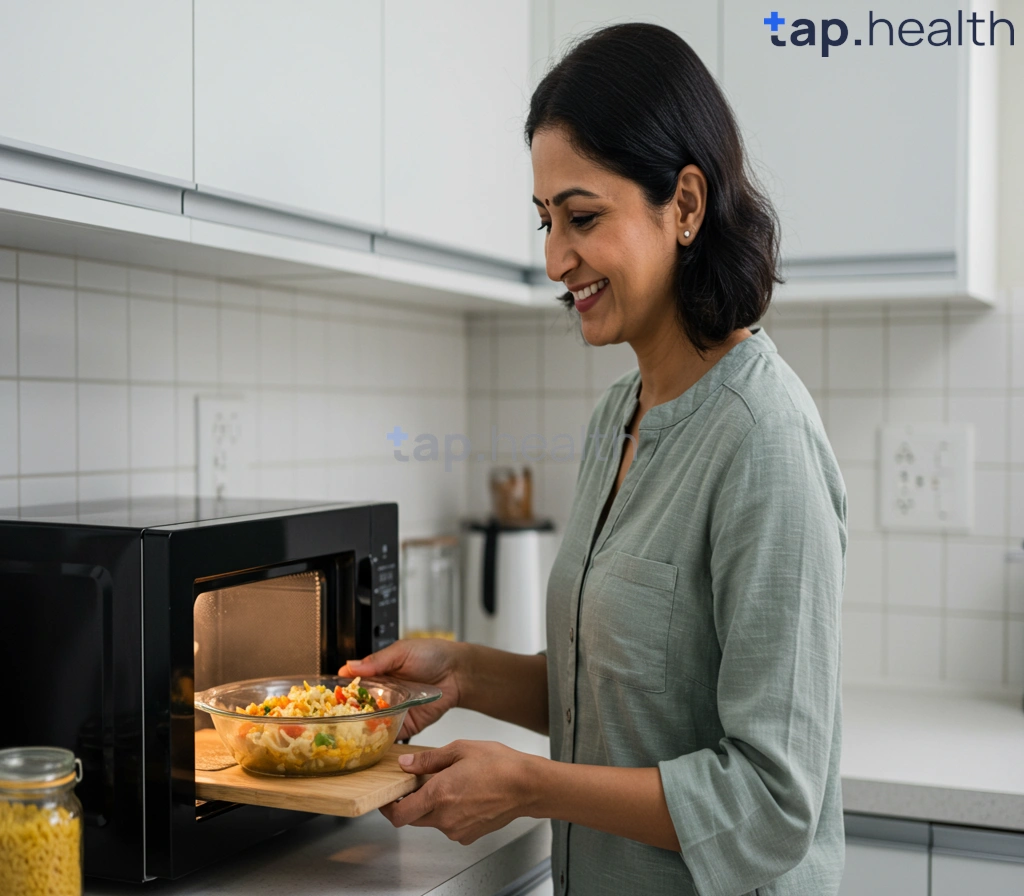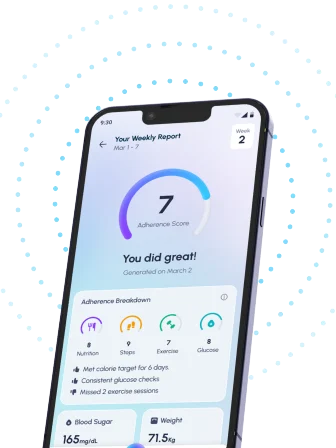Table of Contents
- Safe Leftover Reheating: Diabetes-Friendly Guide
- How to Reheat Leftovers Safely with Diabetes
- Best Practices for Reheating Food: Diabetes Considerations
- Diabetes & Leftovers: Avoiding Blood Sugar Spikes
- Reheating Leftovers Safely: A Diabetic’s Guide to Portion Control
- Frequently Asked Questions
- References
Managing diabetes requires careful attention to diet, and that includes knowing how to safely reheat leftovers. Are you wondering about the best practices to avoid blood sugar spikes after enjoying those delicious dinner remnants? This complete guide, Safe Leftover Reheating for People with Diabetes: A Complete Guide, provides practical tips and tricks to ensure your reheated meals support your health goals, not hinder them. We’ll explore the science behind reheating and blood sugar, offering simple strategies to make leftover management easy and effective. Let’s dive in and learn how to enjoy your favorite meals safely and deliciously!
Safe Leftover Reheating: Diabetes-Friendly Guide
Managing diabetes effectively often involves careful meal planning, and knowing how to safely reheat leftovers is crucial. Considering that 61% of people with diabetes in India and other tropical countries are aged between 20-64 years, according to the IDF Diabetes Atlas, safe food handling practices are paramount for this large and active population. Improper reheating can lead to bacterial growth, potentially causing illness and impacting blood sugar control.
Preventing Bacterial Growth
In hot and humid climates like those prevalent in India and many tropical regions, bacterial growth is accelerated. Therefore, it’s crucial to reheat leftovers thoroughly to a temperature of at least 74°C (165°F). Use a food thermometer to ensure this temperature is reached throughout the food, especially in thicker portions. Reheat only what you intend to consume immediately; avoid repeatedly reheating the same food. Quickly cool and refrigerate leftovers within two hours of cooking to further minimize bacterial growth.
Diabetes-Specific Considerations
Beyond food safety, reheating also affects the glycemic index (GI) of your food. Some reheating methods might increase the GI, leading to faster blood sugar spikes. Opt for methods that retain the food’s original texture and nutritional value. Steaming or microwaving are generally better choices than frying, which can add unhealthy fats and raise the GI. Always portion your leftovers appropriately to help with portion control and blood sugar management. Remember, consistent monitoring of blood glucose levels remains crucial, regardless of reheating methods. For more tips on managing your diabetes, check out How to Prevent Long-Term Complications of Diabetes: Easy Tips.
Safe Reheating Practices for Indian Cuisine
Many popular Indian dishes, such as curries and dals, are commonly reheated. When reheating these dishes, ensure that the spices and ingredients are evenly heated to eliminate any potential bacteria. Consider using a non-stick pan or a microwave-safe container for even heating and to prevent sticking or burning. Always check the internal temperature with a food thermometer to ensure that it has reached the safe temperature to prevent food poisoning. Prioritize food safety and healthy reheating methods to stay healthy and manage your diabetes effectively. Planning ahead is key, especially during holidays. Learn how to create delicious and healthy meals with Creating Diabetes-Friendly Dishes for the Holidays.
How to Reheat Leftovers Safely with Diabetes
Managing diabetes effectively requires careful attention to blood sugar levels. For many individuals in India and tropical countries, a significant portion of daily meals may involve reheating leftovers. However, improper reheating can significantly impact blood sugar control. Studies show that over 30% of diabetes patients have HbA1c levels above 9%, highlighting the need for safe food handling practices. Careful reheating is crucial to preventing spikes in blood glucose levels.
Safe Reheating Techniques for Diabetics
To minimize blood sugar fluctuations, prioritize quick and even reheating methods. Microwaving in short bursts, stirring frequently, is often the best option. Steaming is another excellent choice, preserving nutrients and preventing overcooking, which can lead to a higher glycemic index. Avoid methods like frying or deep-frying leftovers, as these add unhealthy fats and can drastically increase your blood sugar. Always ensure food is heated thoroughly to a safe internal temperature to kill harmful bacteria prevalent in warmer climates.
Portion Control and Food Choices
Remember that portion control remains essential even when reheating. Overeating, regardless of the food, can lead to blood sugar spikes. Choose lean protein sources and non-starchy vegetables whenever possible. Prioritize dishes with a lower glycemic index, and be mindful of added sugars or high-glycemic carbohydrates in your leftovers. Understanding how different cooking methods and food choices affect your blood sugar is key, and you might find our article on How Does Heat Affect Diabetics? helpful.
Diabetes Management in Tropical Climates
In hot and humid climates like those prevalent in India and other tropical regions, food spoilage is a significant concern. Prompt and proper refrigeration of leftovers is paramount to prevent bacterial growth and maintain food safety. Always ensure leftovers are thoroughly chilled before reheating. Consulting a registered dietitian or certified diabetes educator for personalized advice tailored to your region and dietary habits is highly recommended. They can offer guidance on managing diabetes and making informed choices regarding food reheating and overall dietary planning. Making smart food choices is crucial, and if you’re wondering about specific foods, you might find our article on Can a Diabetic Eat Hot Dogs? informative.
Best Practices for Reheating Food: Diabetes Considerations
Understanding Carbohydrate Impact
Reheating leftovers is a common practice, especially in Indian and tropical countries where food is often cooked in larger quantities. However, for individuals with diabetes, managing carbohydrate intake is crucial for maintaining stable blood sugar levels. Remember, a typical meal plan might suggest around 45–60 grams of carbohydrates, but this varies greatly depending on individual needs and activity levels. Therefore, understanding how reheating affects carbohydrate content and glycemic index is vital.
Safe Reheating Techniques for Diabetes Management
Avoid overcooking, as this can increase the glycemic index of certain foods, leading to faster blood sugar spikes. Steaming or microwaving are generally preferred methods over frying, which adds unhealthy fats. When reheating rice, for example, ensure it’s thoroughly heated to eliminate potential bacterial growth, a concern particularly relevant in warmer climates. For curries and stews common in Indian cuisine, prioritize reheating smaller portions to minimize waste and better control carbohydrate intake per serving.
Portion Control and Meal Planning
Careful portioning is key. Even healthy leftovers can negatively impact blood sugar if consumed in excessive quantities. Plan your meals ahead, considering the carbohydrate content of your reheated dishes within your daily allowance. Incorporating non-starchy vegetables into your reheated meals can help to balance the carbohydrate load and promote satiety. Consider using smaller plates to visually manage portion size. For more tips on managing your diabetes effectively, check out our guide on 10 Proven Tips for Effective Diabetes Management.
Regional Considerations for Leftover Management
In hot and humid climates, food spoilage is a significant concern. Proper storage and quick reheating are crucial to prevent bacterial contamination. Refrigerate leftovers promptly and ensure they are thoroughly heated before consumption. Using airtight containers helps maintain freshness and minimize the risk of spoilage. For advice on adapting traditional cuisines to better manage blood sugar, see our article on Adapting Traditional Cuisines for Better Blood Sugar Control.
Diabetes & Leftovers: Avoiding Blood Sugar Spikes
Managing blood sugar levels is crucial for individuals with diabetes, especially in hot and humid climates common across India and tropical countries. Improper reheating of leftovers can significantly impact post-meal glucose levels. Remember, ideal pre-meal blood sugar should be between 80–130 mg/dL, and post-meal levels should be less than 180 mg/dL. Failing to achieve this can lead to complications.
Safe Reheating Techniques for Diabetics in Tropical Climates
Proper reheating is key. Avoid reheating food multiple times, as this can alter its nutritional value and potentially increase its glycemic index (GI), leading to higher blood sugar spikes. Use methods like microwaving or steaming, ensuring the food is heated thoroughly to eliminate harmful bacteria, especially crucial in warmer climates where spoilage is faster. Avoid frying or deep-frying leftovers, as these methods add unhealthy fats and can negatively impact blood glucose control.
Portion Control and Food Choices
In India and other tropical regions, many dishes are rich in carbohydrates. When reheating leftovers, be mindful of portion sizes. Opt for smaller portions to help control your carbohydrate intake and minimize blood sugar fluctuations. Choose leftovers that are lower in carbohydrates and higher in fiber, such as vegetable curries or lentil-based dishes, over rice-heavy options. Adding a side of leafy greens or salads can further help regulate blood sugar levels. For more tips on managing your carbohydrate intake, check out our article on How to Prevent Blood Sugar Spikes After Meals.
Regional Considerations
Consider the specific ingredients in your leftovers. Dishes common in Indian and tropical cuisines, such as those containing coconut milk or certain spices, may affect blood sugar differently. Monitor your blood sugar levels after consuming reheated meals to understand how specific foods impact you personally. Consult a doctor or registered dietitian for personalized advice based on your individual needs and dietary habits. Regular monitoring and adjusting portions is crucial for effective diabetes management, especially in warmer climates. Learning how to prevent blood sugar spikes generally is also important; read more in our guide, How to Prevent Blood Sugar Spikes After Meals.
Reheating Leftovers Safely: A Diabetic’s Guide to Portion Control
Managing blood sugar levels is crucial for individuals with diabetes, especially in hot and humid climates common in India and tropical countries. Food spoilage is a significant concern in these regions, impacting both safety and blood glucose control. Improperly stored and reheated leftovers can lead to spikes in blood sugar, potentially pushing levels from a healthy range (less than 140 mg/dL) into the prediabetes range (140–199 mg/dL) or even higher (200 mg/dL or higher). Careful reheating and portion control are essential.
Safe Reheating Techniques for Diabetics
To minimize blood sugar fluctuations, prioritize safe reheating methods. Avoid repeatedly heating leftovers as this can reduce their nutritional value and potentially increase the glycemic index. Use a microwave for quick and even heating, ensuring food reaches a safe internal temperature. Alternatively, steam or gently simmer leftovers in a pot on the stovetop. Always ensure food is steaming hot throughout before consumption to kill any harmful bacteria that may have developed.
Portion Control: The Key to Stable Blood Sugar
Portion control is just as critical as safe reheating. Even healthy leftovers can contribute to high blood sugar if consumed in excess. Plan your meals in advance and measure out appropriate portions using measuring cups or a food scale. Consider incorporating non-starchy vegetables into your reheated meals to help slow down the absorption of glucose into your bloodstream. Remember, staying within recommended carbohydrate limits is key for managing blood sugar levels. For example, if you’re considering having leftover hamburger, you might want to check out our guide on Can a Diabetic Eat Hamburger? Tips for Enjoying It Safely for more information on portion control and safe food choices.
Regional Considerations for Leftover Management
In hot and humid climates, food spoilage happens quickly. Store leftovers properly in airtight containers in the refrigerator, ideally consuming them within 24-48 hours. If you’re unsure about the freshness of a leftover, it’s best to err on the side of caution and discard it. Proper food storage and safe reheating practices are vital for maintaining healthy blood sugar levels and preventing foodborne illnesses, especially in Indian and tropical countries. Managing blood sugar is also important in conjunction with managing other health conditions. For insights on managing cholesterol alongside diabetes, see our article on How to Manage Cholesterol Levels with Diabetes?
Frequently Asked Questions on Safe Leftover Reheating for People with Diabetes
Q1. How can I safely reheat leftovers to manage my diabetes?
To safely reheat leftovers and manage your blood sugar, ensure your food reaches at least 74°C (165°F) internally. Use a food thermometer to verify the temperature. Microwaving or steaming are the best methods as they minimize added unhealthy fats and glycemic index increases.
Q2. What are the risks of improper leftover reheating for people with diabetes?
Improper reheating can lead to increased bacterial growth, potentially causing illness. It can also negatively impact your blood sugar control, causing spikes or fluctuations.
Q3. What is the best way to store leftovers to prevent bacterial growth?
Refrigerate your leftovers within two hours of cooking to significantly reduce the risk of bacterial growth. This is especially important in hot and humid climates.
Q4. Besides reheating, what other factors should I consider to manage my blood sugar when eating leftovers?
Portion control is key! Even healthy leftovers can cause blood sugar spikes if you overeat. Be mindful of carbohydrate content and choose lower-glycemic options. Regular blood glucose monitoring is also vital.
Q5. Where can I get personalized guidance on managing diabetes and eating leftovers?
Consult a dietitian or diabetes educator for personalized advice tailored to your specific needs and health condition. They can provide valuable insights into safe reheating practices and overall diabetes management.
References
- A Practical Guide to Integrated Type 2 Diabetes Care: https://www.hse.ie/eng/services/list/2/primarycare/east-coast-diabetes-service/management-of-type-2-diabetes/diabetes-and-pregnancy/icgp-guide-to-integrated-type-2.pdf
- Children with Diabetes : A resourse guide for families and school. : https://www.health.ny.gov/publications/0944.pdf




